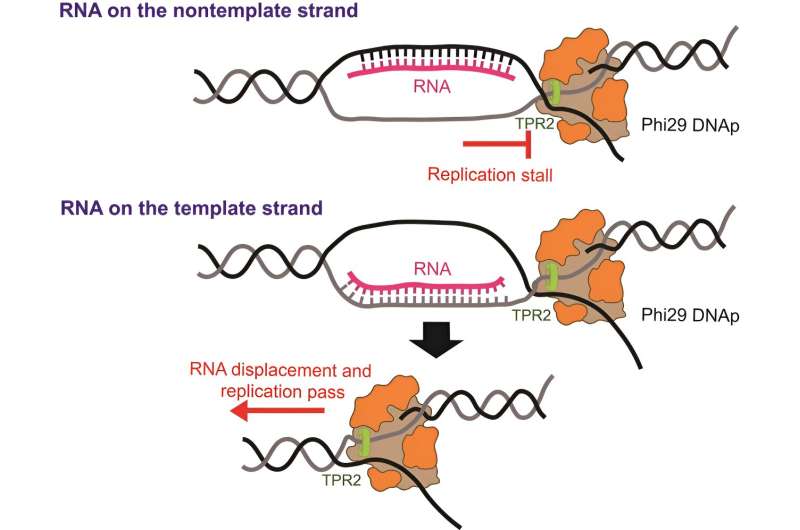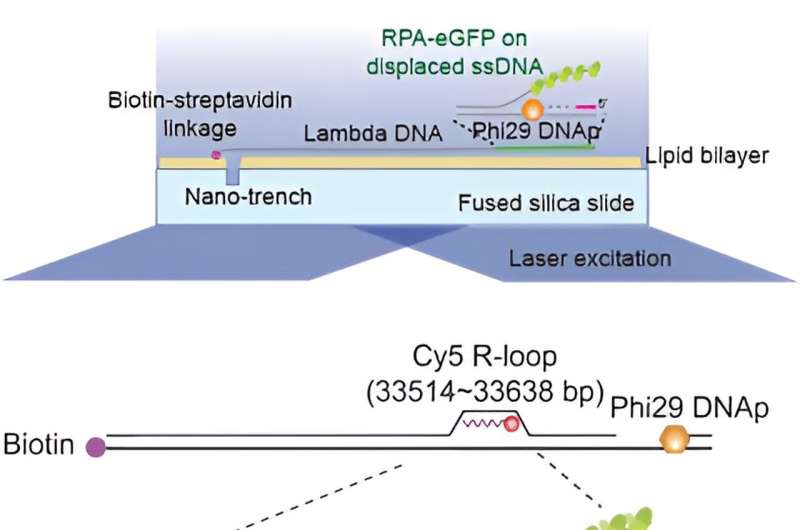This article has been reviewed according to Science X's editorial process and policies. Editors have highlighted the following attributes while ensuring the content's credibility:
fact-checked
peer-reviewed publication
trusted source
proofread
'DNA curtain' technology provides real-time visualization of replication for new scientific insights

A research team, led by Professor Ja Yil Lee in the Department of Biological Sciences at UNIST has made a breakthrough in the field of molecular biology. Their research, published in the journal Nucleic Acids Research, has successfully imaged the real-time process of DNA replication using the innovative "DNA curtain" technology.
This achievement represents the first-ever direct observation of DNA replication and its conflicts with R-loops and transcription proteins, shedding new light on long-standing questions in the field.
DNA replication plays a vital role in transferring genetic information to the next generation. However, it frequently encounters obstacles such as interference caused by the transcription process or collisions with R-loops, which arise from incomplete transcription.
These phenomena, collectively known as "DNA replication stress," have been associated with various diseases, including cancer, neurological disorders, and aging. Consequently, gaining a comprehensive understanding of the conflicts between replication, transcription, and R-loops is of paramount importance for the development of potential disease prevention and treatment strategies.
To directly visualize the process of DNA replication, the research team employed DNA curtain technology, a single-molecule imaging approach. This technique facilitated the direct observation of collisions between DNA replication and transcription or R-loops. Through their experiments, the team demonstrated that even a single R-loop can impede DNA replication and induce replication stress, with a higher degree of blockage observed when an RNA-DNA hybrid is present on the non-template strand.
The team identified that this asymmetry arises from secondary structure formation on the non-template strand, hindering the progression of Phi29 DNA polymerase. Furthermore, the formation of G-quadruplex structures on the displaced single-stranded DNA within an R-loop amplifies replication stalling. In addition, the researchers observed collisions between Phi29 DNA polymerase and RNA transcripts synthesized by T7 RNA polymerase, revealing that RNA transcripts cause more frequent stalling due to the presence of T7 RNA polymerase.

"DNA replication lies at the core of life phenomena, and this study represents the world's first real-time fluorescence imaging of DNA replication and its conflicts with transcription and R-loops," noted Professor Lee. "It provides a direct answer to the long-standing problem in molecular biology known as 'replication-transcription collision.'" He further added, "Moving forward, we aim to apply this groundbreaking technology to further research on human DNA replication and transcription."
Subin Kim, the first author of this study and a Ph.D. researcher, emphasized the significance of the findings, particularly in relation to R-loops, which are actively studied worldwide as potential causes of various diseases, including cancer and neurological disorders such as leukemia. The study is expected to make a substantial contribution to the development of treatments for diseases associated with R-loops.
More information: Subin Kim et al, Direct visualization of replication and R-loop collision using single-molecule imaging, Nucleic Acids Research (2023). DOI: 10.1093/nar/gkad1101
Journal information: Nucleic Acids Research





















